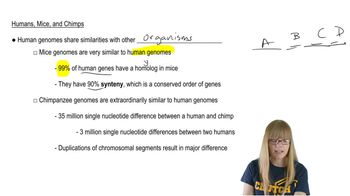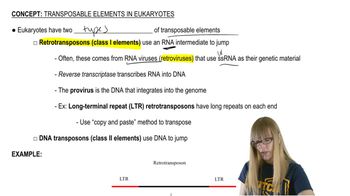Table of contents
- 1. Introduction to Genetics51m
- 2. Mendel's Laws of Inheritance3h 37m
- 3. Extensions to Mendelian Inheritance2h 41m
- 4. Genetic Mapping and Linkage2h 28m
- 5. Genetics of Bacteria and Viruses1h 21m
- 6. Chromosomal Variation1h 48m
- 7. DNA and Chromosome Structure56m
- 8. DNA Replication1h 10m
- 9. Mitosis and Meiosis1h 34m
- 10. Transcription1h 0m
- 11. Translation58m
- 12. Gene Regulation in Prokaryotes1h 19m
- 13. Gene Regulation in Eukaryotes44m
- 14. Genetic Control of Development44m
- 15. Genomes and Genomics1h 50m
- 16. Transposable Elements47m
- 17. Mutation, Repair, and Recombination1h 6m
- 18. Molecular Genetic Tools19m
- 19. Cancer Genetics29m
- 20. Quantitative Genetics1h 26m
- 21. Population Genetics50m
- 22. Evolutionary Genetics29m
15. Genomes and Genomics
Comparative Genomics
Problem 26
Textbook Question
PEG10 (paternally expressed gene 10) is a paternally expressed gene (meaning only the paternal allele is expressed) that has an essential role in the formation of the placenta of the mouse. In the mouse genome, the PEG10 gene is flanked by the SGCE and PPP1R9A genes. To study the origin of PEG10, you examine syntenic regions spanning the SGCE and PPP1R9A loci in the genomes of several vertebrates, and you note that the PEG10 gene is present in the genomes of placental and marsupial mammals but not in the platypus, chicken, or fugu genomes.
The green bars in the figure indicate the exons of each gene. The gray bars represent LINEs and SINEs, and the blue bars represent long terminal repeat (LTR) elements of retrotransposons. Solid black diagonal lines link introns, and dashed black lines connect orthologous exons. Arrowheads indicate direction of transcription.
Using the predicted protein sequence of PEG10, you perform a tblastn search for homologous genes and find that the most similar sequences are in a class of retrotransposons (the sushi-ichi retrotransposons). Propose an evolutionary scenario for the origin of the PEG10 gene, and relate its origin to its biological function. <>
 Verified step by step guidance
Verified step by step guidance1
Identify the presence of PEG10 in placental and marsupial mammals but not in other vertebrates like platypus, chicken, or fugu, suggesting a specific evolutionary event in mammals.
Recognize that PEG10 is flanked by SGCE and PPP1R9A genes, indicating its location within a syntenic region that can be compared across species.
Note the presence of LINEs, SINEs, and LTR elements in the genomic region, which are indicative of retrotransposon activity.
Perform a tblastn search using the PEG10 protein sequence and find similarity with sushi-ichi retrotransposons, suggesting a retrotransposon origin for PEG10.
Propose that PEG10 originated from a sushi-ichi retrotransposon insertion event in the ancestor of placental and marsupial mammals, and its function in placental development may have been co-opted from the retrotransposon's original function.
Recommended similar problem, with video answer:
 Verified Solution
Verified SolutionThis video solution was recommended by our tutors as helpful for the problem above
Video duration:
3mPlay a video:
Was this helpful?
Key Concepts
Here are the essential concepts you must grasp in order to answer the question correctly.
Paternally Expressed Genes
Paternally expressed genes are those genes where only the allele inherited from the father is active, while the maternal allele is silenced. This phenomenon is a key aspect of genomic imprinting, which plays a crucial role in development, particularly in the formation of structures like the placenta. Understanding this concept is essential for analyzing the function of PEG10 in placental development.
Recommended video:
Guided course

Penetrance and Expressivity
Synteny
Synteny refers to the conservation of blocks of order within two sets of chromosomes that are being compared from different species. In the context of PEG10, examining syntenic regions helps identify evolutionary relationships and gene conservation across vertebrates. This concept is vital for understanding how PEG10 has been maintained or lost in various lineages.
Recommended video:
Guided course

Humans, Mice, and Chimps
Retrotransposons
Retrotransposons are genetic elements that can amplify themselves in a genome and are a significant source of genetic variation. They replicate through an RNA intermediate and can insert themselves into new locations within the genome. The relationship between PEG10 and retrotransposons, particularly the sushi-ichi retrotransposons, is crucial for proposing an evolutionary scenario for PEG10's origin and its functional implications.
Recommended video:
Guided course

Eukaryotic Transposable Elements
Related Videos
Related Practice




